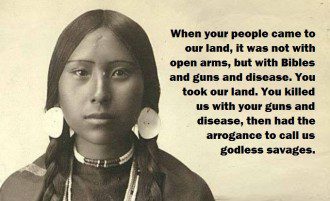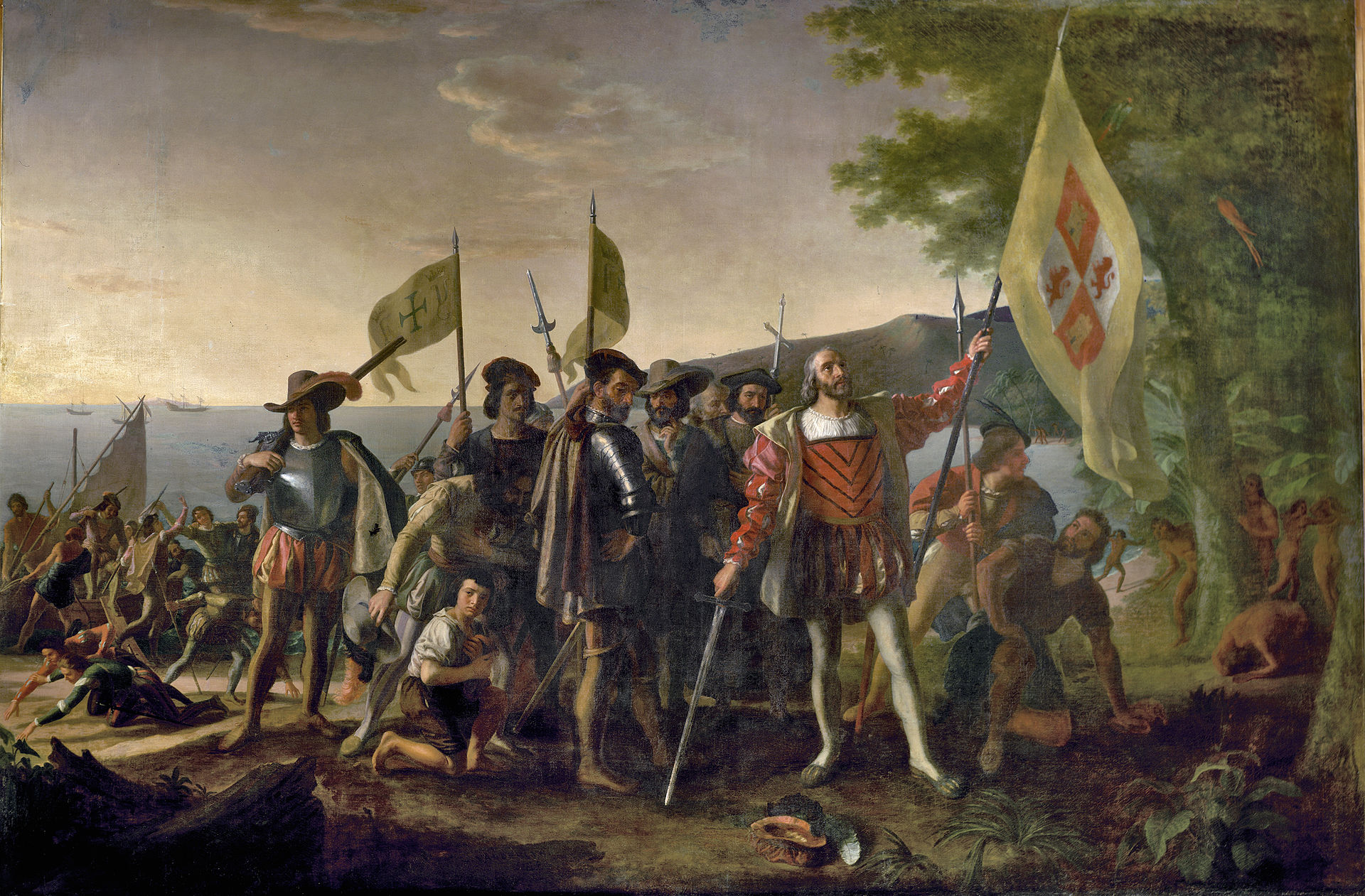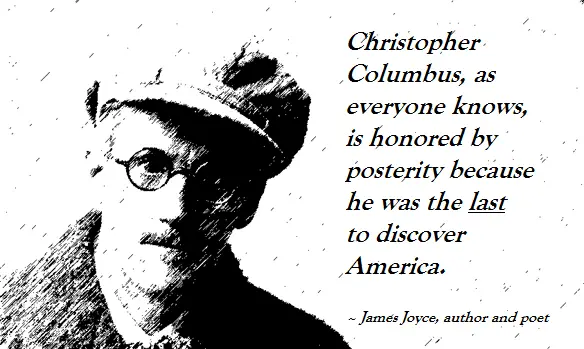By Irwin Ozborne
Contributing writer for Wake Up World
“In 1492, the natives discovered they were Indians, discovered they lived in America, discovered they were naked, discovered that the Sin existed, discovered they owed allegiance to a King and Kingdom from another world and a God from another sky, and that this God had invented the guilty and the dress, and had sent to be burnt alive who worships the Sun the Moon the Earth and the Rain that wets it.” ~ Eduardo Galeano
A good friend of mine, a member of the Republic of Lakotah, had a meeting with her first grade son’s elementary school principal. Apparently, her six-year-old was being defiant in classroom. What were these defiant actions? Well, upon his teacher explaining Columbus Day and honoring the courageous and brave sailor who discovered this land in 1492, he had a couple of questions for the teacher. He wanted to know how it was possible that Christopher Columbus discovered a land in which his ancestors had lived for over 30,000 years, he wanted to know what happened to all the people who lived here in 1491, and he wanted to know why the man responsible for invading his native land and slaughtering his ancestors was being honored.
I would love to just be a fly on the wall of that meeting with the elementary school principal.
Christopher Columbus Did NOT Discover America
There, I said it. The first thing we are told about our nation in our early childhood is a complete fabrication of the truth. But, that is only the beginning of the secret atrocities that shaped the nation that we know today.
The Spanish Conquest of the Americas, preceded by its “discovery” by Christopher Columbus (or Cristóbal Colón as he was known by the Spanish Crown) resulted in mass assimilation, raping, slaughtering, enslaving, and intention to wipe out all evidence of a native population of between 50 and 100 million indigenous people from the land — the greatest genocide in recorded history. These well-documented atrocities include:
- Forced hard labor.
- Abducting and selling children into the sex trade as young as nine-years-old.
- Mass raping of women and children.
- The amputation of limbs if slaves were not producing ‘enough’.
- Labelled as hostile savages if not in complete compliance with their oppressors. Buried alive or burnt alive if you were resistant to the conquerors demands.
- Offering cash rewards for the scalps of men, women, and children as proof of murder.
- Intentionally spreading smallpox disease, an early means of biological warfare.
- Forced removal from homes and land onto small reservations with barren, unlivable conditions.
- Death marches of more than one-thousand miles to these reservations in which, if you were unable to continue the walk, you were left for dead and unable to assist dying family members.
- On these same reservations “reserved” for the indigenous people, once this land was deemed valuable, the reservation agreement was broken and they were forced to move once again. All 370 treaties signed between the U.S Government and Indian nations have been broken by the United States.
- Public execution of those who did not follow orders. Children were murdered by slamming them against stone and tree trunks, while pregnant women’s bellies were sliced open on public display, as a warning to those who did not comply.
- These same mass murderers become labeled as heroes after sweeping through villages and slaughtering unarmed civilians.
- Systematically kidnapping children and forcing them to a boarding school system in which they are beaten, forbidden to speak native language, brainwashed into becoming “Americanized”, and often molested.
- Not entitled to the rights of citizenship in their own land until 1924.
- Not included in the initial civil rights act; did not receive equal legal protections/rights until 1968.
- Not allowed to practice their own ‘religion’/spirituality until 1978.
- In the 1970’s the attendance at these brutal boarding schools peaked and it was not until 1975 that the United States Government emphasized reduction in boarding schools with most of them finally closing in the 1980s and 1990s. In 2007, there were still 9,500 American Indian children kept in boarding schools.
- Traditional lifestyle mocked and ridiculed in mass media and in the classroom – socially acceptable to discriminate against.
- Altered their history by ignoring and denying the truth for the past four centuries.
These were the policies of our government, the United States of America, as well as the the Spanish Crown and the Pope of the Catholic Church. These atrocities weren’t conducted by aliens from outer space; no, they was done by aliens from the east, who entered an occupied land with force to subjugate and exterminate the civilizations that had existed for at least 30,000 years (some estimates are as high as 200,000 years). And although they became icons of the national myth, only a small proportion of colonists were actually pilgrims and puritans, who arrived in the 1620s.
The American Holocaust
Thousand-mile death marches, concentration camps, forced assimilation, mass killings by starvation and the deliberate introduction of disease, the forced adoption of culture and ‘beliefs’… Does this all sounds familiar?
In John Toland’s book “Adolf Hitler: The Definitive Biography”, he comments on the Furor’s admiration of the American Genocide:
“Hitler’s concept of concentration camps as well as the practicality of genocide owed much, so he claimed, to his studies of English and United States history. He admired the camps for Boer prisoners in South Africa and for the Indians in the Wild West; and often praised to his inner circle the efficiency of America’s extermination — by starvation and uneven combat — of the red savages who could not be tamed by captivity.
“He was very interested in the way the Indian population had rapidly declined due to epidemics and starvation when the United States government forced them to live on the reservations. He thought the American government’s forced migrations of the Indians over great distances to barren reservation land was a deliberate policy of extermination. Just how much Hitler took from the American example of the destruction of the Indian nations is hard to say; however, frightening parallels can be drawn. For some time Hitler considered deporting the Jews to a large ‘reservation’ in the Lubin area where their numbers would be reduced through starvation and disease.”
However, that is a harsh reality to teach children in grade school, and not at all conducive to a sense of national patriotism. So, in the retelling of U.S. history, we soften it up a little… or change it altogether.
Discover, Invade, or Conquer?
Discover is defined as finding something in the course of a search.
Invade is identified as an armed force or its commander entering a country/region so as to subjugate or occupy.
Conquer means to overcome and take control of a place or people by use of military force.
The word discover could be applied if something was actually found, but the problem is that Columbus’ so-called “discovery” had belonged to someone else for at least 30,000 years. For perspective, it has only been 2014 years since the “birth of Christ”. That means the first indigenous people first settled the Americas 27,986 years prior; whereas Europeans have only been here for 522 years.
The most interesting part about the definition of the word invade is the term “subjugate”, and the fact that Columbus used this exact word upon his first encounter with the Taino people of the north-east South American continent:
“They … brought us parrots and balls of cotton and spears and many other things, which they exchanged for the glass beads and hawks’ bells. They willingly traded everything they owned… . They were well-built, with good bodies and handsome features…. They do not bear arms, and do not know them, for I showed them a sword, they took it by the edge and cut themselves out of ignorance. They have no iron. Their spears are made of cane… . They would make fine servants…. With fifty men we could subjugate them all and make them do whatever we want.” ~ Christopher Columbus’s log
Interestingly enough the term subjugate is defined as “bringing under domination or control, especially by conquest”, while conquest is simply the act of conquering, which is interlocked with the definition of subjugate. By Columbus’ own words, it is therefore indisputable that the land and people of the North American continent were taken control of by military force. In fact, the exact term used in world history is “The Spanish Conquest.”
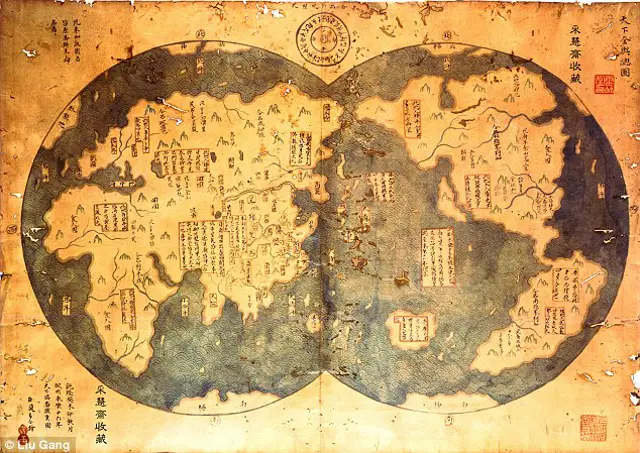
This 18th century copy of Chinese Admiral Zheng He’s 1417 map proves the New World was not ”discovered” by Columbus. The map has been authenticated by appraisers from Christie’s Auctions.
Despite the fact that numerous other nations already knew of the Americas, Columbus’ voyage may have initially been a “discovery” mission. But clearly, upon his first impression of the people of this land it quickly turned to an “invasion”. Following Columbus’ death, Hernán Cortés and Francisco Pizzaro continued the tasks of conquering the Americas.
Now, before you disregard this article as a wacky, conspiracist, anti-American post, please understand that this is more about seeking the other side of the story. It is about viewing the landing of Columbus’s ships on May 12, 1492 from the perspective of the occupants of that land – the Taino and Arawaks perspective.
“When your people came to our land, it was not with open arms, but with Bibles and guns and disease. You took our land. You killed us with your guns and disease, then had the arrogance to call us godless savages. If there is a Heaven and it is filled with Christians, than Hell is the place for me.”
Columbus’s Early Life
Born as Cristofor Colombo (Italian name; Spanish: Cristóbal Colón; Portuguese: Cristóvão Colombo; and American/English: Christopher Columbus) was born in Genoa, Italy, in 1451. He grew up working on ships and began sailing at age 10. After delivering goods to northern Europe in 1476, upon his return his ship was burnt by a group of French sailors and he swam to shore in Portugal. He remained in Portugal and started working for the Kingdom, which had the finest fleet in the world at this time.
During the middle ages, the kingdoms of Europe made their wealth by trading with Asia. But in 1453, the Turkish Empire cut off all land routes between Europe and Asia and the race to find a sea route to Asia soon began. Columbus sailed along the coasts of Africa, trading with the colonies and learning of the currents and wind patterns of the Atlantic. In 1487, another Portuguese sailor, Bartholomeu Dias made his way around the southern tip of Africa and located the eastern coast; giving strong belief to a quicker route to Asia by sea.
Columbus had already believed the world was smaller than that of the common-held belief of this time. Once Dias’ made this discovery, Columbus’s desire to sail west intensified as he had been seeking sponsorship for a trip across the Atlantic as early as 1484.
(Please note that nobody in the 15th century believed that the world was flat. This is an outright lie perpetrated by the American school system. The Greek philosopher Pythagoras first theorized that the earth was a sphere nearly 2,000 years before Columbus was born. Aristotle, 4th century B.C., added more proof to this theory by observing the motion of the stars. As historian Jeffrey Russel Burton once stated, “With extraordinary few exceptions, no educated person in the history of Western Civilization from the third century B.C. onward believed that the Earth was flat.” Except, of course, Christopher Columbus.)
Columbus was rejected funding by Portugal, twice by Italy, Spain, England, and France. However, upon the Spanish kingdom conquering Granada they were more willing to fund his voyage of three ships and 80 men. Struggling to find a crew, Queen Isabella released prisoners early to join the voyage along with other criminals, conquistadors and pig farmers. These men that did not fear dying at sea, as it was for more appealing than what life had in store for them in Spain. Following Spain’s capture of Granada, there were also some unemployed former-military men that were sent along on Columbus’s voyage.
So, in August of 1492, after eight years of trying to make a voyage around the world, Columbus set sail seeking the riches of Asia.
First Voyage
“Christopher Columbus introduced two phenomena that revolutionized race relations and transformed the modern world: the taking of land, wealth and labor from indigenous peoples, leading to their extermination, and the transatlantic slave trade, which created a racial underclass.” ~ American sociologist, historian, and author James W. Loewen, from the book Lies My Teacher Told Me.
The first voyage to the so-called “new world” was highly unsuccessful, despite the credit and admiration it has since received. After weeks at sea, with a disgruntled crew of men, Columbus gave an ultimatum to find land in the next two days or head back to Spain – dated October 10, 1492. As unfortunate fate would have it, two days later Rodrigo de Triana was the first to spot an island, which is the modern-day Dominican Republic, located between Haiti and Puerto Rico. However, with a large payout at stake, Columbus claimed that he actually spotted the light the night before – hence, claiming the lifetime pension from King Ferdinand and Queen Isabella of Spain.
Columbus claimed the land for Spain and renamed it San Salvador although it had been occupied for thousands of years by the Taino, Arawak, and Lucayans (all extremely hospitable peoples, per many written accounts). Early estimates believe there were up to three million indigenous people living in the Caribbean; whereas more recent studies believe that number to be closer to eight million.
As written in his journals upon his first encounter with the Taino:
“These people have no religious beliefs, nor are they idolaters. They are very gentle and do not know what evil is; nor do they kill others, nor steal; and they are without weapons.”
Columbus quickly captured a handful of Taino to help guide him to find gold, while putting many into forced labor and sent thousands back to Spain to be sold as slaves (although most of them died on the journey back across the Atlantic).
“As soon as I arrived in the Indies, in the first island which I found, I took some of the natives by force, in order that they might learn and might give me information of whatever there is in these parts. And so it was that they soon understood us, and we them, either by speech or by signs, and they have been very serviceable.”
Merry Christmas – 1492 Style
After a few weeks exploring around Cuba, Columbus made his way back toward Hispaniola (now the Dominican Republic). On Christmas Eve, the Santa Maria shipwrecked before making it to land. The Arawak Indians saw the men struggling and their chief ordered all his men – including the chief himself – to swim out to sea and help the settlers to safety.
The Arawak invited the settlers into their home. Columbus wrote of the kind hospitality of the Arawaks:
“They are artless and generous with what they have, to such a degree as no one would believe but him who had seen it. Of anything they have, if it be asked for, they never say no, but do rather invite the person to accept it, and show as much lovingness as though they would give their hearts.”
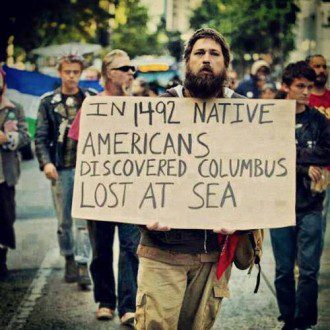 With not enough room on the two remaining ships, Columbus left 39 men behind to settle a fort in which he called La Navidad.
With not enough room on the two remaining ships, Columbus left 39 men behind to settle a fort in which he called La Navidad.
When Columbus returned to Spain, his stories of the new world impressed the King and Queen – mostly due to his large exaggerations of the amount of gold present in the Caribbean. The Spanish royalty granted him another voyage, but this time with 17 ships, 1200 men, plus livestock, and weapons.
Columbus consistently wrote about the kindness of the people that he encountered on his first voyage and shared this with the Kingdom of Spain:
“They are so naive and so free with their possessions that no one who has not witnessed them would believe it. When you ask for something they have, they never say no. To the contrary, they offer to share with anyone….”
“[The natives] brought us parrots and balls of cotton and spears and many other things… They willingly traded everything they owned… They were well-built, with good bodies and handsome features… They do not bear arms, and do not know them, for I showed them a sword, they took it by the edge and cut themselves out of ignorance. They have no iron. Their spears are made of cane… They would make fine servants… With fifty men we could subjugate them all and make them do whatever we want.”
Catholic Conquest
On May 4, 1493, the beginning of the Spanish Conquest took place with the approval of Pope Alexander VI. The Pope stated that any land not inhabited by Christians was available to be “discovered”, claimed and exploited by Christian rulers. He declared that:
“… the Catholic faith and the Christian religion be exalted and be everywhere increased and spread, that the health of the souls be cared for and barbarous nations overthrown and brought to faith itself.”
Disregarding the sovereignty of non-Christian populations, this philosophy became known as the “Doctrine of Discovery” and became the basis for all European land claims in the Americas, and continued with the United States western expansion into the 1800’s. As a United States Supreme Court case in 1823 stated, “the principle of discovery gave European nations an absolute right to New World lands.” Essentially, this doctrine stated that the American Indians had no right to their land, and it was not until 1924 that “Native Americans” were allowed citizenship on the land “discovered” out from under them. (I use the term Native Americans to highlight the irony of not being granted citizenship to their native homeland until 450 years after the Europeans took their land and tried to wipe out their civilization.)
Following his first voyage, Pope Alexander VI granted the “new world” to King Ferdinand and Queen Isabella, claiming:
“We of our own motion, and not at your solicitation, do give, concede, and assign for ever to you and your successors, all the islands, and main lands, discovered; and which may hereafter, be discovered, towards the west and south; whether they be situated towards India, or towards any other part whatsoever, and give you absolute power in them.”
Later, as word of the mistreatment of the natives reached the Spanish Kingdom, Queen Isabella finally made a “stand”: she proclaimed that the Natives shall be given the opportunity convert to Catholicism before being forced into slavery. (Wasn’t that kind of her?!)
Sadly, claiming slaves of anyone non-Christian was not a new trade. Back in 1455 the Pope issued a statement allowing Portugal to enslave any and all non-Christians. Columbus himself got started in slave trading back in 1480’s as he sailed along the West coast of Africa, picking up slaves for the Portuguese kingdom. Then, on his third voyage, Columbus was the first to bring African slaves to the new world in the Dominican Republic (Hispaniola), claiming that “one African slave is equal to four Indians.”
By 1514, the Spanish Conquistadors carried with them an ultimatum entitled, “The Requirement,” in which the Indians were forced to accept “the Church as the Ruler and Superior of the whole world.” The Requirement warned the natives the consequences for non-compliance:
“We shall take you and your wives and your children, and shall make slaves of them, and as such shall sell and dispose of them as their Highnesses may command; and we shall take away your goods, and shall do all the harm and damage that we can.”
Second Voyage
The King and Queen of Spain were eager to fund a second voyage following Columbus’s reports of his first trip to the so-called new world. In his largely exaggerated accounts, Columbus shared that:
“Hispaniola is a miracle. Mountains and hills, plains and pastures, are both fertile and beautiful… the harbors are unbelievably good and there are many wide rivers of which the majority contain gold… There are many spices, and great mines of gold and other metals…”
Columbus returned in 1493 to find the fort at La Navidad had burnt to the ground and all 39 men were killed. It was reported that these men apparently had “misbehaved”. Of course, by “misbehave” it is meant they raped the native women and children and tried to steal whatever they could get hands on, raising the ire of the native population. In hindsight, leaving 39 recently released criminals behind, with no rules and laws, this outcome should not have surprised Columbus. However the Spaniards retaliated and Columbus forced all natives age 14 or older to work in the mine fields daily, searching for gold. If they refused, they were killed. If they did not meet quotas each month, their hands and arms were amputated.
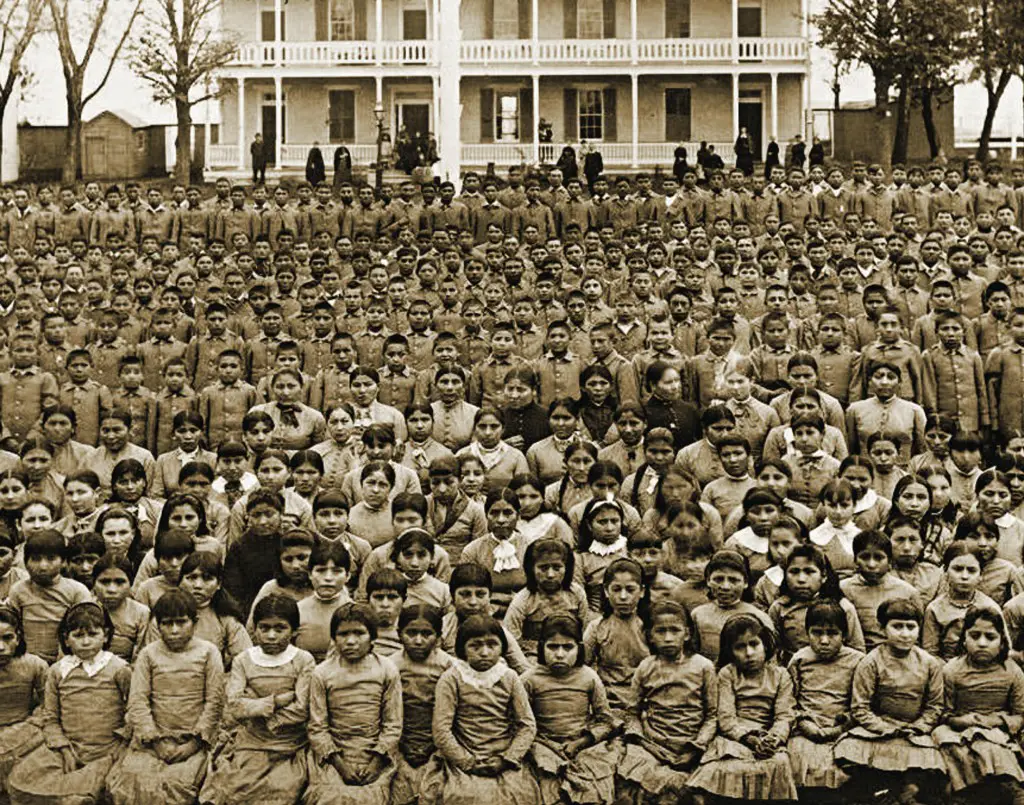
The government engaged in a cultural assimilation campaign, forcing thousands of Native American children into boarding schools.
Many began committing suicide to avoid the tortures of the Spaniards, while others were buried alive for refusing to oblige to Columbus. The Taino were being killed by starvation, worked to death, disease, or murder. The women were given to the Spaniards to do as they chose.
Columbus wrote of the innocence of the Natives and his intent to sell them into the slave trade:
“Naked as the day they were born, they show no more embarrassment than animals… Let us in the name of the Holy Trinity go on sending all the slaves that can be sold.”
With not enough gold to return to Spain in triumph, Columbus rounded up the best one-thousand Taino he could find. He gave half to the Spanish colonists and took the other half to be sold to the slave trade in Spain. As 250 of the 500 died en route back to Spain, the conquistadors simply tossed their bodies overboard. With much disorder among the colonists at this time, Columbus left his brothers in charge of the islands as he returned to Spain.
Third Voyage
Upon his return, the island was in more disarray than when he left. Columbus embarked on daily beatings, raping, feeding infants to wild animals, and progressing the sex trade of children. Columbus began selling girls as young as nine years old into the sex trade, as accounted in own his writings:
“A hundred castellanoes are as easily obtained for a woman as for a farm, and it is very general and there are plenty of dealers who go about looking for girls; those from nine to ten are now in demand.”
At the same time, a man named Bartolome De Las Casas was aboard the third voyage with Columbus and was the first to speak out about the crimes against humanity in the so-called new world. As word got back to Spain of Columbus’s crimes, the King and Queen had Columbus and his brothers arrested and shipped back to Spain.
While settling into Hispaniola in hopes of fortune in the new world, La Casas was a slave owner himself until 1509, after which he started speaking out against the crime. However, he still believed in converting non-Christians to Christianity — but in a peaceful, non-violent way. While this was applauded by the royalty of Spain, it was simply not followed by the Conquistadors. La Casas wrote of these atrocities:
“Endless testimonies… prove the mild and pacific temperament of the natives… But our work was to exasperate, ravage, kill, mangle and destroy… And the Christians, with their horses and swords and pikes began to carry out massacres and strange cruelties against them. They attacked the towns and spared neither the children nor the aged nor pregnant women nor women in childbed [childbirth], not only stabbing them and dismembering them but cutting them to pieces as if dealing with sheep in the slaughter house. They laid bets as to who, with one stroke of the sword, could split a man in two or could cut off his head or spill out his entrails with a single stroke of the pike. They took infants from their mothers’ breasts, snatching them by the legs and pitching them head first against the crags or snatched them by the arms and threw them into the rivers, roaring with laughter and saying as the babies fell into the water, “Boil there, you offspring of the devil!”
The Forgotten Legacy of Christopher Columbus
Columbus was arrested, shipped back to Spain and stripped of all his land and titles of “discoverer”. However, he did find a way to be released and allowed to explore once again – the promise of gold! He presented gold to the King and Queen – a bribe – and was not only pardoned for his crimes but allowed a fourth voyage.
Christopher Columbus passed away in 1506 always believing he had landed in Asia, with no knowledge that the Americas was an entirely different continent. During the ten years of his four voyages (1492-1502) the population of Taino decreased from an estimated 3 to 8 million inhabitants to less than 50,000. By the mid 1500’s that number was reduced to just 500 remaining Taino.
Before the European invasion of the Americas, there were believed to be as many as 80-100 million native people occupying what is now the United States. According to the 2010 U.S. Census, only 5.2 million people in the U.S. identified as American Indian and Alaskan Native, either wholly or in part, and out of this total only 2.9 million people identified as solely American Indian or Alaska Native. At the time of European invasion, at least 300 different languages were spoken in addition to numerous “trade languages”. The natives of the Americas were not only “living lightly on the land”, as is so often claimed, but were engaged in landscaping, building and agriculture, trade and commerce, in addition to sustainable hunting and gathering, and of course, ancient cultural and earth-based spiritual practices — much of which has now been decimated.
Christopher Columbus — a liar, thief, rapist, pedophile, savage, torturer, genocidal murder, brutal conqueror, and pioneer of slavery and sex trades — did not discover anything besides a beautiful, peaceful group of people who had lived sustainably on their land for millennia; who rescued him and welcomed him into their home. Implementing what can only be described as sociopathic imperialism, his thirst for wealth, greed and power wiped out generations of people within a decade. And for his “bravery”, we celebrate the day he invaded the land of the people that rescued him.
Columbus Day has been celebrated as federal holiday in the United States since 1971. Then, on 9th October 2002, President George W. Bush issued a presidential proclamation celebrating “Columbus’ bold expedition [and] pioneering achievements” and directing that “the flag of the United States be displayed on all public buildings on the appointed day in honor of Christopher Columbus.” Of course, noticeably missing from his recounting of history was any mention of invasion, violence, slavery, rape, religious persecution or genocide — a history that our nation proudly celebrates each Columbus Day.
“The people who are citizens of the U.S., these are your treaties. They aren’t just the Indians’ treaties. No one gave us anything. No one was dragging any land behind them when they came here. This was our land… As native American peoples in this red corner of Mother Earth, we have no reason to celebrate an invasion that caused the demise of so many of our people, and is still causing destruction today.” ~ Suzan Shown Harjo, the Morning Star Institute, a national Native American rights organization.
Further reference:
- www.endcolumbusday.com
- Columbus, The Indians, and Human Progress — Howard Zinn: www.genius.com/Howard-zinn-chapter-1-columbus-the-indians-and-human-progress-annotated
- www.understandingprejudice.org/nativeiq/columbus.htm
- Christopher Columbus: The Untold Story — www.historyguide.org/earlymod/columbus.html
- Does this map prove that China discovered America before Columbus? — George Dvorsky: http://io9.com/does-this-map-prove-that-china-discovered-america-befor-1442911790
- American Colonies: The Settling of North America — Alan Taylor: www.amazon.com/American-Colonies-Settling-North-America/dp/0142002100
-
Historical Myth: Columbus ‘Discovered’ America; The Canary Effect; www.agreenroad.blogspot.com/2012/12/historical-myth-columbus-discovered.html
- Lies My Teacher Told Me — James W. Loewen www.amazon.com/Lies-My-Teacher-Told-Everything/dp/0743296281
- 1491: New Revelations of the Americas Before Columbus — www.amazon.com/1491-Revelations-Americas-Before-Columbus/dp/1400032059
Recommended articles by Irwin Ozborne (with Cortland Pfeffer):
- Over The Rainbow: The (Yellow Brick) Road to Enlightenment
- Licensed to Kill: Psychiatry, Big Pharma and the State-Sanctioned Drug Cartel
- Celebrating Genocide – Christopher Columbus’ Invasion of America
- The Craving Behind the Craving: Addiction as a Spiritual Disease
- Bipolar? Or Gifted? The Modern Day Epidemic of Medicated “Madness”
- Suicide: Falling Through the Cracks of Stigma
- The Fictions Surrounding ADHD and the “Chemical Imbalance” Theory of Mental Illness
- Schizophrenia – Psychosis or Something More Profound?
- The War On Drugs: How the “Land of the Free” Became the “Home of the Slaves” for 2.3 Million Americans
- What If We Are The “Bad Guys”?
About the author:
Irwin Ozborne and his partner Cortland Pfeffer founded the community Taking The Mask Off in 2014 to help shine a light on the mental health industry (as well as other areas of our society that are shrouded in deceit and misinformation) and share insider perspectives and real life stories that have been gathered over 20 years in the psychiatric field.
An avid historian, Irwin Ozborne (a pen-name) is a survivor of childhood abuse and torture over a period of 13 years, and a recovered alcoholic. As a mental health practitioner, today Irwin practices holistic care and incorporates eastern philosophy into his work with clients. He is available for speaking engagements as well, and can be contacted via email: [email protected]

If you've ever found value in our articles, we'd greatly appreciate your support by purchasing Mindful Meditation Techniques for Kids - A Practical Guide for Adults to Empower Kids with the Gift of Inner Peace and Resilience for Life.
In the spirit of mindfulness, we encourage you to choose the paperback version. Delve into its pages away from screen glare and notifications, allowing yourself to fully immerse in the transformative practices within. The physical book enriches the learning process and serves as a tangible commitment to mindfulness, easily shared among family and friends.
Over the past few years, Wake Up World has faced significant online censorship, impacting our financial ability to stay online. Instead of soliciting donations, we're exploring win-win solutions with our readers to remain financially viable. Moving into book publishing, we hope to secure ongoing funds to continue our mission. With over 8,500 articles published in the past 13 years, we are committed to keeping our content free and accessible to everyone, without resorting to a paywall.

